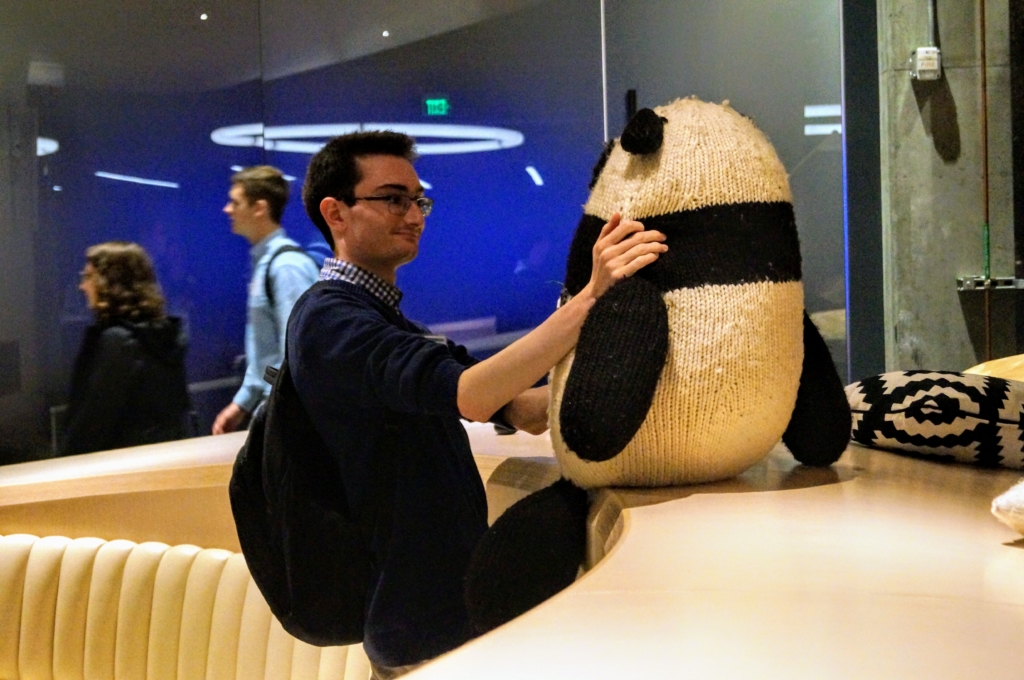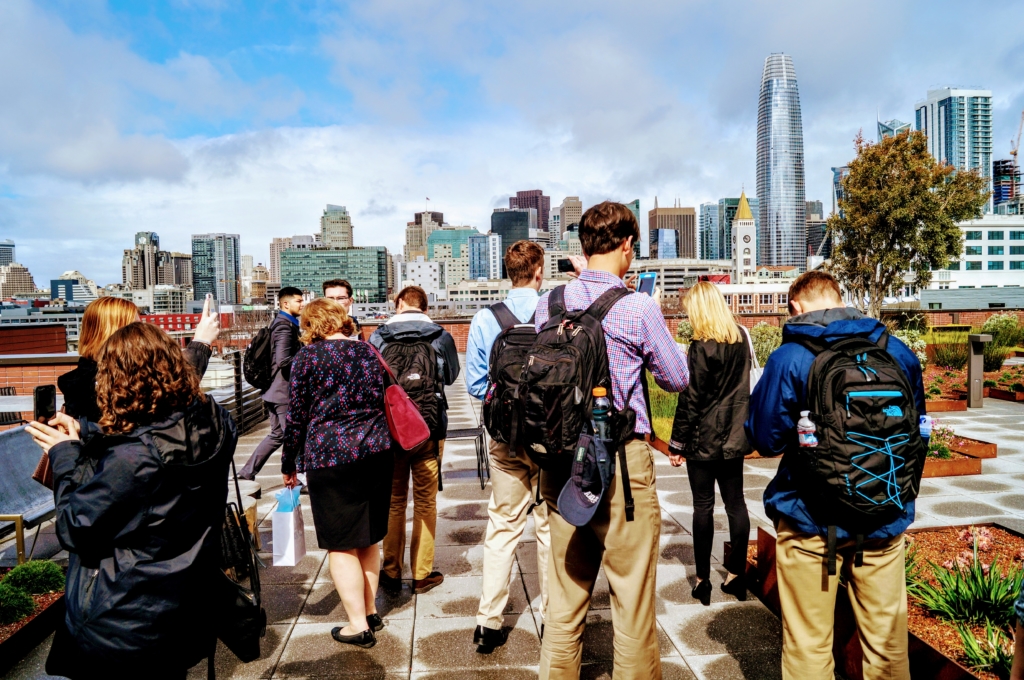
A North Carolina Kenan-Flagler student at Dropbox headquarters in San Francisco. Photo by Nathan Allen
In a room full of various musical instruments, bean bags, and a pool table, a group of 12 undergraduate students from the University of North Carolina’s Kenan-Flagler Business School gather around Justin Bethune, Dropbox’s head of MBA recruiting, decked out in a flat-brimmed baseball hat and down jacket. The students and two career management staff members have travelled cross-country during the school’s spring break to explore Silicon Valley and up the peninsula to the middle of San Francisco where they now sit in Dropbox’s headquarters. Their trip has taken them to the Googleplex to Cisco and LinkedIn to the culmination of their weeklong trip, Dropbox. At Dropbox, students got face-time with campus recruiters and Carolyn Feinstein, Dropbox’s chief marketing officer and a Kenan-Flagler MBA graduate. They also got a tour, which included a rooftop stop and finished in Dropbox’s food court-style cafeteria.
“I want them to know this is an option for them if they choose to pursue it,” Amy Bugno, the associate director of Career Development for the undergraduate program at Kenan-Flagler tells P&Q.
It’s the second time Bugno has led a spring break trip for North Carolina undergrads to the West Coast. “The intent is to expose students to the opportunities that are out there in technology and on the West Coast,” she continues. It’s easy for Kenan-Flagler students to understand industries like consulting and investment banking, Bugno says, and what it would be like to work in cities along the Eastern Seaboard, because traditionally, that’s where the majority of alumni have gone to work. “Those companies are coming to campus, they are sharing information with our students, and we have a lot of alumni in those fields,” she says.
Indeed, Kenan-Flagler sent 56% of its graduating Class of 2017 to finance or consulting, according to the school’s career report. But, the next highest industry was tech with 12% of the class going into the industry. Geography-wise, only 7% went to the West region, which is defined as 10 West Coast and Mountain West states. Nearly a third of the class stayed in North Carolina and another 50% went to the Northeast, South, or Mid-Atlantic states. But, again, that’s shifting, Bugno says. “Although it’s not our top draw for students, it’s gaining more and more interest,” Bugno says of the tech industry.
TECH CLIMBING ON SCHOOL EMPLOYMENT REPORTS
Other Eastern-based schools are seeing the same uptick. At the University of Pennsylvania’s Wharton School, interest in the West Coast tech trek has recently doubled. The University of Virginia’s McIntire School of Commerce also recently began making trips to the San Francisco Bay Area. And Georgetown University’s McDonough School of Business took their first trip to the Bay Area and second to the West Coast earlier this spring.
“We have a higher level of student interest but not a lot of companies coming to campus to talk to students,” Rebecca Cassidy, the assistant dean and director of the Office of Professional Development at Georgetown’s McDonough School of Business says of tech companies. Cassidy’s office began organizing tech trips similar to the school’s consulting and investment banking treks. Similar to Kenan-Flagler, the trips are also for exposure — both for the students and the companies. “What they see and know are the companies that come on campus,” says Cassidy, adding that is usually the banks and Big Four consulting firms.
While financial services and consulting still dominate the McDonough employment report, Cassidy says in 2017 about 10% of the class went to IT or tech, up from 6% in the Class of 2016. At Wharton, about 15% of 2017’s graduating class went into technology, which is the highest rate ever for the school. Since 2012, when just 4% of the class entered tech, the rate has ticked up each year to 6% in 2013, 9% in 2014, 10% in 2015, and 13% in 2016. At Virginia McIntire, 5% of the Classes of 2017 and 2016 went into tech, which was a slight uptick from 2% in 2015. Kenan-Flagler’s 12% in 2017 was an increase from 10% in 2016.

Kenan-Flagler students explore the rooftop office space at Dropbox headquarters in San Francisco. Photo by Nathan Allen
‘TRYING TO COMBAT’ THE IDEA TECH IS ONLY INTERESTED IN WEST COAST RECRUITING
When Bugno arrived at Kenan-Flagler’s career services office in 2016, there were already treks for consulting and investment banking, mainly to New York City. She began wondering if there were opportunities to expand to different geographies or industries. “I kept coming back to the idea of the West Coast and the technology industry,” she says. And this year, the plan became a reality. Bugno says there is at least one main difference between the investment banking and consulting treks and the tech trek.
“The firms are evaluating students very early on and through every interaction they have,” Bugno says of the investment banking and consulting treks. On the investment banking trek, students are expected to have a much deeper grasp on the industry and companies. “It is essentially part of the interviewing process for them,” Bugno says.
But that’s not necessarily the case on the tech trek, which is more of an introduction and exploration to the tech world. It’s also about showing them working in tech on the West Coast is attainable — even if they’ve never been to California, Oregon, or Washington before.
“The students who went with me last week, many of them in their applications or conversations I had with them said things like, ‘that industry is really just focused on Stanford and Berkeley and schools on the West Coast,'” Bugno explains. “I’m really trying to combat that idea.”
Data has shown the top feeder schools to Silicon Valley are indeed the University of California-Berkeley and Stanford, but other Midwestern and East Coast schools have solid pipelines into the valley, so it’s not unrealistic to think North Carolina and Kenan-Flagler, specifically, could be one of those moving forward.
At Georgetown, Cassidy says California is now the largest base of applicants to the school. “It is a slow climb, but it is real and happening,” Cassidy says. “So we’re trying to give them opportunities that are going back west.”
Cassidy also says the main purpose of the trip is to show students heading to tech and the West Coast is attainable and they don’t have to take the investment banking or consulting route just because that’s what most people do.











Questions about this article? Email us or leave a comment below.